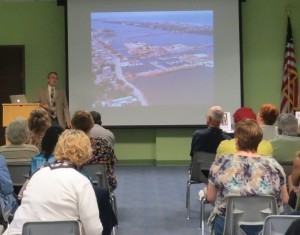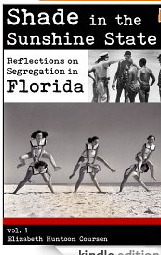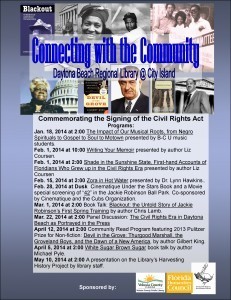Michael A. Pyle's Blog, page 175
April 6, 2014
Talk on White Sugar, Brown Sugar at Daytona Beach City Island Library
I’m very grateful to all the people who came to City Island Library today to listen to me babble about White Sugar, Brown Sugar. Many had already read it, and many had already listened to me before. I can’t even believe they spent time on a Saturday afternoon listening to me. And many even bought copies of the books afterwards. Wow. I was telling Davita Bonner that my talk the week before last to the John H. Dickinson Friends of the Library annual luncheon was the most exciting event I had had so far, and today has continued that.
One can purchase signed copies on this site at http://mikepylewriter.com/buy-the-book/ (The price there includes domestic postage, but it’s signed,) and at Daytona Beach Barnes & Noble (Local Author Section), Connie’s Bookshelf in Daytona Beach Shores, and Down by the Sea Gift Shop & Gallery in Flagler Beach.
(I will be participating in the Author’s Forum at Daisy Stocking Park next Saturday and Sunday, where I will have the book for sale without postage added.) Note, I think Google and every other site has it wrong about where that park is. I believe it’s next to BCU, NOT in Holly Hill.


April 1, 2014
Presentation about White Sugar, Brown Sugar This Saturday
I will be presenting about White Sugar, Brown Sugar, this Saturday, April 5, at 2 p.m. at the City Island Library.


March 16, 2014
Len Lempel – Historian on Panel of Civil Rights Panel Discussion at City Island Library
Leonard “Len” Lempel is one of the panelists at the Civil Rights Panel Discussion on Saturday, March 22 at 2 p.m. at the Daytona Beach, City Island Library. I have not known Len very long, but have learned much about him. He is one of those people who has quietly researched and become enmeshed with historical issues, largely including racial history, spanning many, many years, and contributed to many publications about such subjects. Although his part of the panel discussion may not seem extensive, he has a wealth of information to share.
Len is in the blue shirt in the middle on the right side, having lunch with Chris Lamb, author of Blackout, the Untold Story of Jackie Robinson’s First Spring Training, Mike Pyle, Mrs. Lempel, Deborah Shafer of the Daytona Beach City Island Library and another panelist, with a wealth of information, James Daniels.
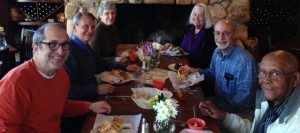 Len previously was a professor at Bethune Cookman College, now Bethune Cookman University. Now, he is a professor of history at Daytona State College. I have found articles that he has written, is mentioned in or is quoted in everywhere I look, including some about the Freemanville Settlement in Port Orange, and later local Black history. He is a member of the Board of Directors of the Halifax Historical Society.
Len previously was a professor at Bethune Cookman College, now Bethune Cookman University. Now, he is a professor of history at Daytona State College. I have found articles that he has written, is mentioned in or is quoted in everywhere I look, including some about the Freemanville Settlement in Port Orange, and later local Black history. He is a member of the Board of Directors of the Halifax Historical Society.
Len has an interest in local racing as well, being named in various racing web sites. He recently was one of the driving forces in bringing a film of historical racing clips and interviews to life, as the result of a grant he received to do so. The film, “Hoppin’ Rattlesnakes: Oral Histories of Beach Racing in Volusia County, 1903-1958” has been shown around town recently. Although many publications do not mention Len’s involvement, he was very involved in the production of this interesting film.
This is what the library publication about the talk has to say about Mr. Lempel:
“Leonard Lempel
Len was born in New York City and grew up in Northern New Jersey. He received a B.A. in History from the University of Akron, and both an M.A. and Ph.D. in Social Science from Syracuse University’s Maxwell School of Citizenship and Public Affairs. A Professor of History since 1996 at Daytona State College, Len teaches courses in United States and African American history. Len has numerous publications and has made several presentations at professional conferences and community forums, mostly on the history of Daytona Beach’s African American community, race relations, and political activity. Currently he is co-producing (with Eric Breitenbach) a full length documentary film titled: Hoppin’ Rattlesnakes: Oral Histories of Beach Racing in Volusia County 1903-1958.
Len is President -Elect of the Florida Historical Society, a member of the Southern Historical Association, and serves on the Board of Directors of the Halifax Historical Society. He is a founding member of Sister Cities of Volusia County and serves as the organization’s Historian. Len is Past President of Volusia County’s United Nations Association (UNA-USA), and a past member of the Daytona Beach Historic Preservation and Community Development Boards. He is also a former Vice President of the Halifax Historical Society, is Editor of the Society’s journal, The Halifax Herald, and is a frequent contributor of articles to that publication.”


March 15, 2014
Civil Rights Panel Discussion at Daytona Beach City Island Library March 22 at 2 P.M.
Civil Rights Panel Discussion
 Come and connect with your community as Tampa Bay Times opinion columnist Bill Maxwell and others present a panel discussion about reporting on the 1960s and 1970s-era civil rights movement in Daytona Beach.
Come and connect with your community as Tampa Bay Times opinion columnist Bill Maxwell and others present a panel discussion about reporting on the 1960s and 1970s-era civil rights movement in Daytona Beach.
Maxwell at the time was editor of the free underground newspaper the Westside Rapper, an anti-establishment publication begun by Charles Cherry, Sr. as part of efforts to bring the war on poverty to Volusia County. Maxwell also wrote a weekly column for the Gainesville Sun and The New York Times and was an investigative reporter in Fort Pierce.
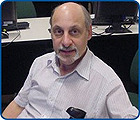 Joining him on the panel will be Leonard Lempel, professor of history at Daytona State College; Elaine Moore Smith, historian and daughter of Richard V. Moore, former president of Bethune-Cookman University; James Daniels, longtime Daytona Beach resident and local businessman; Lois Frey Sessoms, retired dean of general studies at Bethune-Cookman University and professor of English there from 1967-2004; Michael Pyle, local attorney, author and lifelong Volusia County resident; and Daytona Times publisher Charles Cherry II.
Joining him on the panel will be Leonard Lempel, professor of history at Daytona State College; Elaine Moore Smith, historian and daughter of Richard V. Moore, former president of Bethune-Cookman University; James Daniels, longtime Daytona Beach resident and local businessman; Lois Frey Sessoms, retired dean of general studies at Bethune-Cookman University and professor of English there from 1967-2004; Michael Pyle, local attorney, author and lifelong Volusia County resident; and Daytona Times publisher Charles Cherry II.
Persons who lived in Volusia County during the 1960s and early 1970s are especially invited to attend and participate in an open discussion that will follow the presentation.
This program is part of the library’s Connecting with the Community Series, a two-year program funded in part by a Partnership Grant from the Florida Humanities Council.
Saturday, March 22, 2014 at 2 pm at the Daytona Beach Library on City Island.
For more information call Deborah Shafer at 257-6036, ext. 16264.
with funding from the Florida Humanities Council.


Friends of the John H. Dickerson Heritage Library Annual Luncheon
Today, I had the great honor and privilege of being the presenter at the John H. Dickerson Heritage Library annual author luncheon. I hope the attendees got as much out of it as I did. This is a branch of the Volusia County Library system, located at 411 S. Keech Street, Daytona Beach. I got to visit it recently, and was very impressed by the beautiful, busy, well-organized library. Members of the John H. Dickerson family, who always promote the annual Friends of the Library event and give a donation, were present. I didn’t renounce it this week, because I knew it was sold out as of Tuesday.
I had donated a number of copies of my novel, White Sugar, Brown Sugar for all the branches in the past. I learned that Ms. Janice Shaw and Ms. Davita Bonner had learned about the book because of the donation, had read it, and suggested it as the theme of this year’s luncheon. I appreciate all of the people involved in the library and its Friends of the Library for inviting me, including besides Ms. Shaw and Ms. Bonner named above, Marian Rivers and Sallie Shelton Culver. I know there are many more, but I do not really know everybody’s role.
The luncheon was held at the Halifax River Yacht Club, of which I was a member and my father a Commodore when I was young. It is the setting of the beginning and end of White Sugar, Brown Sugar, so the setting was very appropriate, in my eyes.
I always worry that Blacks who grew up in this community, and really experienced segregation and all the ugliness that the Black community has had to endure at some time in their lives, would think poorly of my novel, and think that I have no authority or true knowledge to write what I wrote. I feel better about it today, because I did not percieve any concerns like that. In fact, I received only positive comments about that aspect of it.
I got to meet Dr. Gwendolyn Goldsby Grant, former advice columnist for Essence Magazine, who told me that it was the first time she had seen an author try to meld the racial and cultural aspects in the way I did. And she was very enthusiastic about that. Actually, she hasn’t even read the book yet, so hopefully she still feels the same way afterwards.
I have not before spoken to such an interested, exuberant, supportive crowd, and I have not before had the privilege of selling so many copies of my book at once. And I really appreciate my good friends, like Leon Gillis, Dr. Evelyn Bethune, Donna Gray-Banks, attending. I had the great, great privilege of having Eva Murphy, also known as Eva Pearl Murphy, attend. She is named in my acknowledgments, and is the model behind Pearl Mae, in the book. She worked in my house from the time I was six, when she was sixteen. My wife, Maria also attended and gave support.
They gave me a lovely card, and a very lovely bookmark, engraved to me.


March 7, 2014
Daytona Beach News Journal 3/7/14 – Local attorney Michael A. Pyle featured at author luncheon
This is a full quote from a copyrighted article:
By Rick de Yampert rick.deyampert@news-jrnl.com
Published: Friday, March 7, 2014 at 5:30 a.m.
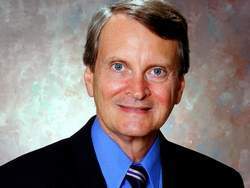
Photo provided by Michael A. Pyle Attorney Michael A. Pyle is the author of the novel “White Sugar, Brown Sugar.”
Local attorney featured at author luncheon An author luncheon will feature a local attorney whose novel depicts “two innocent, naive boys as they struggle through racial and cultural diversity” in the 1960s.
Michael A. Pyle, author of “White Sugar, Brown Sugar,” will be featured at the 14th Annual Author Luncheon of the Friends of the John H. Dickerson Heritage Library.
The luncheon will be held at 11:30 a.m. March 15 at the Halifax River Yacht Club, 331 S. Beach St., Daytona Beach.
Tickets are $25 and are available from any member of the friends or at the library at 411 S. Keech St., Daytona Beach. Tickets must be purchased by Tuesday March 11. Proceeds raised by the friends benefit the library.
For more information, call 386-239-6478 or 252-9850.
Set in Daytona Beach, “White Sugar, Brown Sugar” tells the story of two boys – one white and one black — who become friends despite the racial segregation and upheavals of the 1960s.
According to the website mikepylewriter.com, the novel “follows their loss of innocence, submergence to the depths of desperation” due to substance abuse, and their “eventual emergence as recovering adults.”
Although Pyle “had first-hand knowledge of most of the negative experiences described in the book,” the tale “is not an autobiography — it is completely fiction,” the website says.
Pyle currently is an Ormond Beach resident.
Copyright © 2014 News-JournalOnline.com — All rights reserved. Restricted use only.
http://www.news-journalonline.com/article/20140307/ENT/140309623/1193/ent?template=printpicart


March 3, 2014
I’m on a Book Blog Tour – a What?
Thank you to Darlene Duncan (www.darleneduncan.wordpress.com) for inviting me to participate in a “blog tour.” I had heard of this concept before, but had never seen one or participated in one. The idea is something like a book tour, but without leaving home.
My task is to answer some questions, put them on my blog, provide Darlene my blog information, and perhaps connect with some other people who are doing the same thing. Our combined fans and followers will see the other authors’ posts. So we share excitement from a number of followers.
1) What am I working on? As always, I am working on a million things at once.
What I am Working on – 1. Last year, I self-published a novel that I’d been working on since about 1973. So it only takes me about forty years to finish a book. Just kidding, the one that’s coming out next has only been in the works for about 15 or so years. The book I have published is called White Sugar, Brown Sugar. Here is the description about it:
The Inland Waterway separates beach-side communities from the mainland on Florida’s east coast. In the 60′s, it also segregated races and cultures. White Sugar / Brown Sugar follows two innocent, naive boys as they struggle through racial and cultural diversity.
David “Jude” Armstrong has grown up in a safe, upper middle-class white world on the beach side with his parents and sister. The tranquility ends when his alcoholic mother tosses his father out of the house. Roosevelt Harris lives in a Black community on the mainland with his grandparents, his frequently-disappearing, heroin-addicted mother, and other family members. Although both have witnessed the misery of drug abuse, they both follow the same path. Jude’s father becomes a guiding light for both boys.
White Sugar, Brown Sugar follows their loss of innocence, submergence to the depths of desperation and eventual emergence as recovering adults. It is a story of deep friendship, hope, strength, and inspiration.
Why am I working on it, considering it’s already published? I’m working on marketing and creating an audio book. This book was printed in 2012, in print and e-book. I first wrote it under a pen name, E.G. Tripp, because I had a fear that my clients (I am a practicing attorney) might shun me when they saw the nature of the book. Some months later, 2013, after getting great reviews, starting with followers of the “I Grew Up in Daytona Beach!” Facebook page, and other reviewers, and after a number of my clients found out about it and did not shun me, I changed the author to my own name.
I am a big fan of audio books, and always wanted to have White Sugar, Brown Sugar in audio book format. I obtained some auditions through Amazon’s audio book network, but finally decided I could do it as well myself. I hope I’m right. So I am going to Tropical Studios, owned by a man named Jeff White, a couple of evenings a week to record it. We have finished the recording and are now editing and polishing it. Then, I will upload it to Amazon’s company, Audible.com, and create CDs.
I am spending a lot of time marketing the book, because beyond Daytona Beach, not many people know of it. And since it is not published by a traditional publisher, the big bookstores will not put it in their physical stores. Barnes and Noble has had it on its on-line service since the beginning, but only the local store gets it in stock once in a while.
Besides this blog, I have a Facebook Page by the same name, a Twitter account, a personal Facebook page, and a Pinterest page. I try to post photos and matters of interest about old Daytona Beach, race relations in Florida and elsewhere in the fifties and sixties, and drug abuse and recovery, all topics of the novel.
White Sugar, Brown Sugar was named number two in the 2013 Wall Street Journal’s Reader’s Choice Best Books of the Year list.
What I am Working on – 2. Cuban Sugar (working title). This is the novel I’ve been working on only for fifteen or twenty years. This novel explores two major areas, death and dying, and how people have been affected by the Cuban Revolution. The main character is a Cuban-American man, dying in a hospital in Miami. He cannot move, speak or make his thoughts known in any way. He relives his nice early life in Cuba, and the bad things that happened to him, his family and friends. His family and law partner deal with all their separate concerns. The Cuban part of the story is based partly on the lives of my wife and various family members. She was sent away to Spain on her own when she was seven, and separated from her family, some of whom were stuck in Cuba, for six years. I started interviewing a cousin in Miami many years ago about what happened in Santiago de Cuba, and his escape by raft. I have visited Cuba five times, and been to every museum I can find there. I just returned two weeks ago from Santiago de Cuba, where I continued my research.
The novel is complete, in the hands of two initial reviewers. I had a doctor friend evaluate it, especially to see if my descriptions of the medical condition made sense, and my daughter, who regularly is involved with my writing and marketing. She has been calling me with suggestions. In a few weeks, I hope to get it to an official reviewer, and then get it published.
I hope to have it translated to Spanish, and to create it as a print book, e-book and audio book as well.
What I’m Working on – 3. I have another blog, and related Facebook page, called Cuba Libre Today. I created it a few years ago, during my first visit to Cuba. I post photos, little oddities that people who’ve never been there wouldn’t know about, articles, and other items on the blog and the Facebook page. I have a vague idea of creating a day-in-the-life account of a Cuban and a visitor to Cuba, with photos. This would be a cross between a written story and a photograph book. It will have fewer words than many books, but more photos than most books. I have met a young relative of my wife in Santiago de Cuba, and we are collaborating on this book, writing from our own perspectives. It’s difficult because my Spanish is passable, but not literary, and her English is insignificant. It’s also difficult because Internet in Cuba is almost impossible to access. They have Internet connections for basic e-mail, with up to a Megabyte of data per e-mail, and another daily cap. And, their e-mail is watched, so we have to be careful not to be overly critical. And all the problems of daily life in Cuba causes comical reasons we often cannot communicate at all. But so far, we are having fun, and we are not going to post any of the story until it comes together. We are going to post the book as separate posts on the blog and Facebook page, and then perhaps publish it as a combined work.
What I’m Working on – 4. I have another novel finished but not polished, about something that happened in Cuba. I’m putting it aside for a bit.
What I’m Working on – 5. I started two more novels two years ago, and am only a little way into both of them. They address current events, take place in Daytona Beach, Cuba and other countries, and use a lot of the characters in my other books. But I’ve had to slow down while I finish the audiobook, finish publishing Cuban Sugar, etc.
2) How does my work differ from others of its genre? Do I even have a genre? Well, I know I’m supposed to, but if I do, I’m not sure my varied books really have the same genre. They are adult fiction. Sometimes they are literary. I generally have a point I want to talk about, and I think it would be very boring to write an essay saying what I want to say. So I make up people and make up a story. That’s it. Is that different from anybody else? I don’t know. My first novel delves deeply into drug abuse, addiction and recovery, while at the same time dealing with historical issues that really bother me, including racism, segregation, and issues like that. I’ve included a few deaths there. My second novel is in the mind of a person who’s dying. That’s not really a unique concept, but I think I’ve put a unique twist on it. My writing style is kind of light, humorous and sarcastic (at least that’s what I think), though I bet some don’t find it that way. I try to use more active verbs and fewer adjectives. I try to get into the minds of the characters and describe everything from the individuals’ perspectives. I don’t know of any work that has dealt with the geographical features of Florida, and race, and drugs and recovery, or has dealt with Daytona Beach, and Cuba, and death, and the Cuban Revolution, at least in the same way. So that’s how they are different.
3) Why do I write what I do? I have to. It’s my entertainment. I’ve wanted to be a writer since I was in my early twenties. I started writing White Sugar, Brown Sugar at that time. When I was in my mid-twenties, I took creative writing at the University of Florida from Harry Crews and Sterling Watson. I wrote short stories in that class about drug abuse, racism, segregation, and the same issues I write about now, except that Cuba wasn’t part of my life then. I wrote a short story in that class named, “Campbell Street,” about what occurred on the street in Daytona that is now known as Martin Luther King, Jr. Blvd.
Once upon a time, I tried to write fiction-based law books, in a self-help format, but I just couldn’t even keep myself interested. I did publish English grammar and reading comprehension books for foreign students many years ago, and I was making things up then too, making up grammar rules, and reading comprehension exercises. I am not a good oral story-teller.
4) How does your writing process work? I start thinking about a story. I sometimes write a vague outline. I often don’t stick to the outline. I write the story. Then I spend a long time playing with it, adding, subtracting, editing. I do not have a particular time of day I write. Often, during writing time, I’m working on marketing, posting, reviewing photographs, thinking. I have a deal with my wife, in that I don’t go home on Wednesday evenings, until about ten. It started when I was in a writing group with Julie Eberhart Painter and Darlene Duncan on Wednesday nights some years ago. When the group fizzled, or I was invited to leave because some found my descriptions (especially sexual ones) a little too graphic, we decided I’d keep writing on that evening. But I work on writing in some manner every day.
It takes me a long time and a lot of editing, to describe something the right way. I don’t do it well on my feet. I often act things out, to see if they work.
………….
Well, I tried to convince some others to let me identify them to be on this blog tour next week, but nobody else ever heard of one either, so I have no names to list. If any of my friends sees this and wants to do it next week, let me know and I’ll add you.


February 1, 2014
Shade in the Sunshine State: Reflections on Segregation in Florida – Published
A new book, Shade in the Sunshine State: Reflections on Segregation in Florida, has been published by Elizabeth Coursen of Sarasota, Florida. This book is an anthology of sorts, in that, in addition to writings by the author herself, it contains personal accounts written by a number of Florida residents who experienced some effect of segregation in Florida. As of today, only the e-book appears on Amazon.com, but I believe the print version will appear soon.
http://www.amazon.com/dp/B00I2XFPU2/ref=rdr_kindle_ext_tmb
Stories of two Volusia County residents appear in this book: Michael A. Pyle’s A Naive Florida White Kid’s Perspective of Race Relations in the 50′s and 60′s, and Dr. Evelyn Bethune’s Greetings from Dr. Evelyn Bethune.
Pyle’s account describes how as a child on the beachside of Daytona Beach, Florida, he had few Blacks in his life, and little knowledge of issues of prejudice, segregation and racial discord. He describes his relationships he had with Blacks, his father’s reaction to negative racial remarks, and how and why he was naive to the problems of the local Black population. He describes how he eventually became somewhat aware of prejudice and desegregation, and how a few Black students finally arrived at Seabreeze High School in his senior year, in 1971. He specifically talks about Ernest Brown (“Browny”), who was a hero to all the kids who hung out at Halifax River Yacht Club.
Dr. Bethune’s account describes being in the family of Mary McLeod Bethune, and growing up on the campus of what is now known as Bethune Cookman University. She explores many of the amazing things that her grandmother created and brought to life. If you’ve never heard Evelyn Bethune speak about these subjects, I promise that she will pull you into the life of an amazing person who created an amazing legacy.
The book contains many very interesting and telling accounts of racial segregation in Florida. The author, Ms. Coursen explains the photographs on the cover. The white, female cheerleaders are from a post-card that shows Florida beach life. The photo of the police officers motioning for Black men to leave a beach was from a “Wade-in” that occurred in Fort Lauderdale, Florida.
Ms. Coursen is traveling the state describing the book (along with her other writings). Her presentation in Daytona on February 1, 2014, was amazing. She displayed many photos and post cards (from her post card collection), as well as describing facts that many of us had not heard before. Her talk is very well presented, and the materials are very interesting. Here is her travel schedule, but note that not every talk is about this topic. 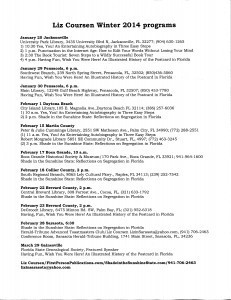


January 25, 2014
Shade in the Sunshine State, An Anthology: Reflections on Segregation in Florida
Liz Coursen has edited and published an account of segregation in Florida, as written by a number of local citizens. I am one of the contributors. Liz is making two presentations at City Island Library in Daytona Beach on February 1, one of which is about this book.
February 1 Daytona Beach
City Island Library
105 E. Magnolia Ave.
Daytona Beach FL 32114
Deborah Shafer (386) 257-6036
10-11:30 a.m. Yes, You! An Entertaining Autobiography in Three Easy Steps
2-3:30 p.m. Shade in the Sunshine State: Reflections on Segregation in Florida
About Liz Coursen:
Elizabeth Huntoon Coursen, Sarasota
award-winning author, editor, and publisher. Author of:
The Complete Biography Workbook,
Brunswick and Bowdoin College,
Self-Editing for the Self-Published Author, and
The Book Tourist: Seven Steps to a Wildly Successful Book Tour
www.FirstPersonPublications.com
www.AmericanPostcardArt.com
www.HavingFunWishYouWereHere.com


January 22, 2014
Connecting with the Community
— atCity island Library.



